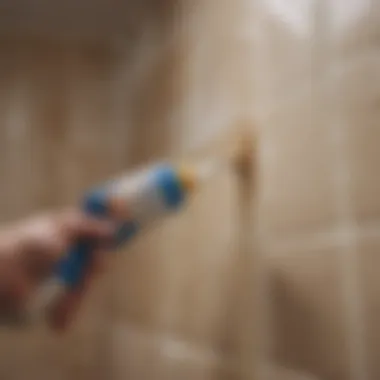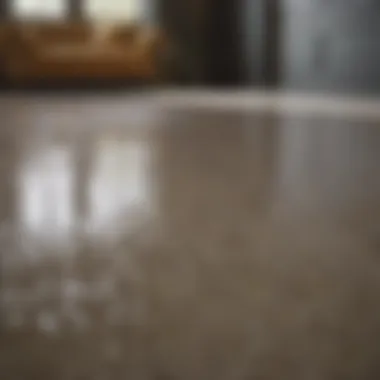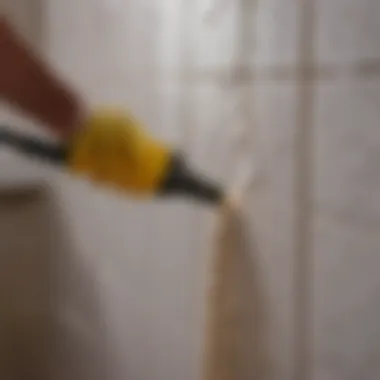Materials:
- Grout: 1 bag (10 lbs)
- Caulk: 2 tubes (10 oz each)
- Tile Spacers: 1 pack (100 pieces)
- Silicone Sealant: 1 tube (10.1 oz)
- Utility Knife
- Caulk Gun
- Grout Float
- Sponge
DIY Steps:
-
Prepare the Surface: Ensure the area is clean and dry before starting. Remove any old grout or caulk to create a smooth surface for application.
-
Mix Grout: Follow the manufacturer's instructions to mix the grout to the desired consistency. Use a stirring stick to achieve a smooth paste.
-
Apply Grout: Using a grout float, spread the grout over the tiles at a 45-degree angle, ensuring all spaces are filled.
-
Clean Excess Grout: Use a damp sponge to wipe off excess grout before it dries, ensuring a clean finish.
-
Let Grout Cure: Allow the grout to cure for at least 24 hours before proceeding.
-
Apply Caulk: Cut the tip of the caulk tube at a 45-degree angle and insert it into the caulk gun. Apply a smooth bead of caulk along edges and corners to seal gaps.
-
Smooth Caulk: Use a wet finger or a caulk finishing tool to smooth out the caulk bead for a clean finish.
Technical Aspects:
- Time Required: 2 days
- Tools Needed: Utility knife, caulk gun, grout float, sponge
- Critical Techniques: Ensuring all gaps are properly filled with grout, smoothing out caulk for a seamless finish
DIY Project Process:


-
Sequential Steps: Follow the steps in order, from preparing the surface to applying and finishing the grout and caulk.
-
Troubleshooting Tips: If the grout or caulk begins to dry too quickly, mist it lightly with water to extend working time. If caulk application appears uneven, use a wet finger for smoothing.
Introduction


In the realm of construction and home improvement projects, understanding the differences between grout and caulk is paramount when it comes to waterproofing. These materials play a crucial role in ensuring the longevity and integrity of various installations, such as tile joints, flooring, walls, bathtubs, showers, windows, doors, sinks, and countertops. The efficacy of grout and caulk in preventing water infiltration can make or break the success of a project, highlighting the significance of this exploration. By delving into the nuances of their composition, application, and waterproof properties, individuals can make informed decisions regarding which material best suits their specific needs.
Grout, composed of water, cement, and aggregate, serves as a common choice for sealing tile joints, flooring, and walls. Its ability to resist water penetration relies heavily on proper sealing techniques adapted during application. On the other hand, caulk comes in various forms such as silicone, acrylic, and polyurethane, each tailored for specific applications like sealing leaks in bathtubs, showers, windows, doors, sinks, and countertops. Understanding these distinctions is fundamental in optimizing the waterproofing capabilities of grout and caulk for distinct areas of the home.
The fluidity and simplicity of grout application contrast with the more precise and detailed process involved in caulking, requiring different maintenance considerations in the long run. Evaluating factors such as durability, flexibility, resealing requirements, and cleaning ease is crucial to ensuring the longevity and efficiency of the chosen material. Furthermore, the visual appeal and ease of use play a significant role in determining the overall aesthetics and functionality of the finished project. In this article, we will unravel the intricacies of grout and caulk, providing a comprehensive guide to help readers navigate the complexities of waterproofing their spaces with confidence.
Understanding Grout


Grout plays a crucial role in construction and home improvement projects, serving as a versatile material for filling gaps and providing structural support. Understanding the properties and applications of grout is essential for ensuring the durability and water resistance of various surfaces. By exploring the composition, application techniques, and waterproof characteristics of grout, homeowners can make informed decisions to protect their investments.
Composition of Grout
Water Content
The water content in grout is a key element that helps facilitate the hydration reaction with cement, allowing the mixture to flow smoothly and fill gaps effectively. Optimal water content ensures proper bonding and strength, while excess water can lead to shrinkage and reduced durability. By carefully controlling the water content during grout preparation, contractors can achieve the desired consistency and performance for specific applications.
Cement
Cement is the binding agent in grout that provides strength and resilience to the mixture. Portland cement is commonly used due to its ability to harden and form a durable matrix when mixed with water and aggregates. The chemical reaction between cement and water creates a solid structure that can withstand varying environmental conditions, making it a reliable choice for waterproofing and sealing applications.
Aggregate
Aggregates such as sand and gravel are essential components in grout that contribute to its density, workability, and final appearance. The size and type of aggregate used can impact the strength and texture of the grout, influencing its performance in different settings. By selecting the appropriate aggregate materials, contractors can tailor the grout mixture to meet specific project requirements and enhance its overall effectiveness.
Application of Grout
Tile Joints
Grout is commonly applied to tile joints to fill gaps and provide a cohesive finish to tiled surfaces. Proper grout application in tile joints helps prevent water penetration, mold growth, and structural damage, ensuring the longevity of the installation. Different grout types can be utilized based on the tile material and joint width, offering flexibility and customization options for various design aesthetics.
Flooring
Grout is instrumental in sealing and reinforcing the seams between flooring materials such as ceramic, porcelain, or natural stone tiles. Its waterproof properties create a protective barrier that shields the underlying structure from moisture and stains, maintaining the integrity and aesthetics of the flooring surface. Regular grout maintenance is necessary to preserve its resilience and extend the lifespan of the flooring installation.
Walls
Grout serves as an essential component in wall constructions, securing masonry units and enhancing the structural stability of interior and exterior walls. By filling the gaps between bricks, stones, or blocks, grout prevents water infiltration and air leakage, promoting energy efficiency and thermal insulation. Proper application techniques and material selection are key considerations in ensuring the effectiveness and longevity of grout in wall assemblies.
Waterproof Properties of Grout
Factors Affecting Waterproofing
The waterproofing capabilities of grout are influenced by various factors such as material composition, application method, and environmental conditions. Proper substrate preparation, adequate curing time, and quality control measures play a significant role in enhancing the waterproof performance of grout installations. By addressing potential weak points and vulnerabilities, contractors can minimize water damage risks and maintain the structural integrity of tiled surfaces.
Sealing Techniques
Sealing grout joints is a common practice to enhance their water resistance and prevent moisture intrusion in vulnerable areas. Sealants are applied on top of cured grout lines to create a protective barrier against dirt, stains, and water infiltration. Regular resealing intervals and proper sealant selection are essential for preserving the longevity and aesthetics of grout installations, ensuring they remain resistant to water damage and environmental wear.
Exploring Caulk
Caulk plays a pivotal role in home improvement and construction projects, offering a crucial barrier against water infiltration and ensuring the durability of various structures. In this article, we delve deep into the importance of caulking, highlighting its specific elements and benefits that make it an indispensable material in maintaining the integrity of surfaces. Understanding the types of caulks available in the market is essential for selecting the most suitable option for different applications.
Types of Caulk
Silicone Caulk
Silicone caulk is renowned for its exceptional flexibility and waterproofing properties, making it a top choice for sealing gaps and joints in wet areas like bathrooms and kitchens. Its key characteristic lies in its ability to resist mold and mildew, ensuring a clean and sanitary environment. While silicone caulk offers excellent adhesion and durability, it may require additional care during application due to its curing time.
Acrylic Caulk
Acrylic caulk is favored for its versatility and ease of use in a wide range of applications, from sealing cracks in walls to filling gaps around windows and doors. Its primary advantage lies in its paintability, allowing for seamless blending with surrounding surfaces for a cohesive look. However, acrylic caulk may be less resistant to moisture compared to silicone, necessitating regular inspections and maintenance.
Polyurethane Caulk
Polyurethane caulk excels in outdoor applications and areas exposed to high levels of moisture, such as decks and exteriors. Its key characteristic includes superior adhesion and flexibility, accommodating the natural movements of structures without compromising the seal. While polyurethane caulk offers robust waterproofing capabilities, it may require specialized tools for application and cleanup.
Caulk Application Areas
Bathtubs and Showers
Caulking in bathtubs and showers is crucial for preventing water seepage into walls and floors, mitigating the risk of mold growth and structural damage. The key characteristic of caulking in wet areas is its ability to withstand prolonged exposure to moisture, ensuring a long-lasting seal. However, frequent cleaning and reapplication may be necessary to maintain optimal performance.
Windows and Doors
Caulking around windows and doors serves as a barrier against drafts and water intrusion, enhancing energy efficiency and maintaining interior comfort. The key characteristic of caulking in these areas is its insulation properties, reducing heat loss and noise transmission. Regular inspection and repair of caulking are essential to prevent air leaks and weather damage.
Sinks and Countertops
Caulking around sinks and countertops is essential for preventing water damage to cabinets and underlying structures, prolonging the lifespan of kitchen and bathroom fixtures. The key characteristic of caulking in these spaces is its resistance to staining and moisture, maintaining a hygienic environment. However, proper ventilation and periodic recaulking are vital for preserving the integrity of the seal.
Waterproofing with Caulk
Sealing Leaks
Caulk is an effective solution for sealing leaks in pipes, faucets, and fixtures, preventing water wastage and potential property damage. The key characteristic of caulking leaks is its immediate sealant properties, offering a quick and temporary fix for minor plumbing issues. However, identifying the root cause of leaks is essential to avoid recurrent problems and ensure long-term water tightness.
Preventing Water Damage
Caulk serves as a proactive measure to prevent water damage in vulnerable areas like basements, attics, and windows, safeguarding properties from costly repairs and structural decay. The key characteristic of using caulking for water damage prevention is its flexibility and adaptability to various substrates, accommodating unique structural requirements. Regular maintenance and inspection are crucial for addressing potential weak points and ensuring continuous protection against water intrusion.
Comparing Grout and Caulk
In the realm of construction and home improvement projects, the comparison between grout and caulk holds immense importance due to their pivotal roles in waterproofing. Understanding the distinct properties, benefits, and considerations surrounding grout and caulk is essential for making informed choices that align with specific project needs.
Waterproof Performance
-
Durability:
When it comes to waterproof performance, durability stands out as a key aspect worth considering in the comparison between grout and caulk. The durability of a material dictates its long-term ability to withstand exposure to moisture, rendering it crucial in preventing water infiltration. Grout, known for its robust composition of water, cement, and aggregate, exhibits exceptional durability in maintaining a watertight seal over time. This characteristic ensures that grout remains intact and effective in thwarting water seepage, making it a popular choice for areas prone to high moisture levels. Despite its resilience, the downside of grout's durability lies in its susceptibility to cracking over extended periods, necessitating periodic maintenance to uphold its waterproofing efficacy.
-
Flexibility:
The flexibility of grout and caulk plays a significant role in their waterproof performance. Flexibility refers to the material's ability to accommodate slight movements and fluctuations without compromising its sealing properties. Caulk, particularly silicone and polyurethane variants, exhibit notable flexibility, making them ideal for sealing joints and gaps that are prone to expansion and contraction. This characteristic allows caulk to adapt to changing environmental conditions, ensuring a tight seal that prevents water intrusion effectively. However, the downside of extreme flexibility in caulk is its potential to degrade faster in areas with constant movement, necessitating more frequent reapplication compared to grout.
Maintenance Considerations
-
Resealing Requirements:
An essential maintenance consideration when comparing grout and caulk is their respective resealing requirements. Grout, due to its porous nature, may require regular resealing to maintain its waterproof properties and prevent moisture absorption. While effective in initial sealing, grout's porous composition makes it vulnerable to water penetration over time, necessitating periodic reapplication of sealant to reinforce its barrier against moisture. On the other hand, caulk, particularly silicone variants, offers greater longevity without frequent resealing due to its non-porous composition, providing a more hassle-free maintenance option for areas with minimal exposure to water.
-
Cleaning Ease:
When considering maintenance, the ease of cleaning surfaces treated with grout or caulk is a critical factor to contemplate. Grout, with its textured surface and porous composition, tends to trap dirt, grime, and mildew, making cleaning a more labor-intensive task. Regular scrubbing and resealing become imperative to prevent discoloration and mold growth in grout joints. In contrast, caulk's smooth and non-porous surface facilitates effortless cleaning with regular soap and water, requiring minimal effort to maintain its appearance and waterproofing integrity over time.
Aesthetics and Application
-
Visual Appeal:
In evaluating aesthetics, the visual appeal of grout and caulk emerges as a distinguishing factor influencing the overall look of tiled surfaces. Grout, with its range of color options and ability to blend seamlessly with tile joints, enhances the cohesive appearance of tiled areas. The visual consistency provided by well-applied grout contributes to a polished and sophisticated look, elevating the overall aesthetic appeal of tiled surfaces. However, the drawback of grout lies in its susceptibility to staining and discoloration over time, necessitating regular upkeep to preserve its visual allure.
-
Ease of Use:
Ease of use plays a pivotal role in determining the practicality of grout and caulk application for various projects. Grout application involves mixing precise ratios of water, cement, and aggregate to achieve the desired consistency before carefully spreading it into tile joints. While grout application requires attention to detail and proper curing time, it offers a durable and long-lasting waterproofing solution suitable for high-moisture areas. In contrast, caulk application, especially with silicone variants, involves straightforward dispensing and smoothing of the sealer into gaps and joints, making it a user-friendly option for quick fixes and small-scale projects where flexibility is a priority. However, caulk's less robust composition compared to grout may require more frequent maintenance to sustain its waterproofing efficacy.
Conclusion
In this comprehensive exploration of the waterproof properties of grout versus caulk, the significance of choosing the right material for a construction or home improvement project cannot be understated. The Conclusion section serves as the pivotal endpoint where readers can synthesize the wealth of information presented throughout the article.
One of the key takeaways is the critical role that waterproofing plays in ensuring the longevity and structural integrity of various surfaces in a home. Grout and caulk, while both serving as effective barriers against water infiltration, differ in their composition, application, and performance over time.
By understanding the nuances of grout and caulk, readers are empowered to make informed decisions based on their specific needs and preferences. The Conclusion segment acts as the final piece in the puzzle, consolidating the insights gained from exploring the waterproof properties of these materials.
Furthermore, the Conclusion section emphasizes the importance of regular maintenance and upkeep to preserve the waterproofing efficacy of grout and caulk. Whether resealing joints or cleaning surfaces to prevent mold and mildew growth, proactive measures can prolong the lifespan of these materials and mitigate potential water damage.
Overall, the Conclusion encapsulates the essence of the article by highlighting the practical implications of selecting between grout and caulk for waterproofing purposes. It underscores the need for careful consideration based on factors like durability, flexibility, maintenance requirements, and visual appeal to achieve optimal results in construction and home projects.





